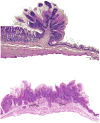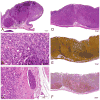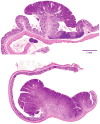Chemical carcinogenesis of the gastrointestinal tract in rodents: an overview with emphasis on NTP carcinogenesis bioassays
- PMID: 20019352
- PMCID: PMC3166531
- DOI: 10.1177/0192623309356452
Chemical carcinogenesis of the gastrointestinal tract in rodents: an overview with emphasis on NTP carcinogenesis bioassays
Abstract
Cancers of the stomach and large intestine (LI) are the second and fourth leading causes of human cancer mortality. A review of the National Toxicology Program (NTP) database and the Carcinogenic Potency Database (CPDB) reveals that chemically induced neoplasms of the gastrointestinal tract (GIT) are relatively common. Within the GIT, epithelial tumors of the forestomach in mice and rats and LI of the rat are most common. Generally, there is a high species concordance for forestomach with at least 26 chemicals inducing tumors in both species. Glandular stomach tumors are rare, and the few reported are usually neuroendocrine tumors (carcinoids) originating from the enterochromaffin-like (ECL) cells. Of 290 carcinogenic agents identified by the NTP, 19 (7%) caused intestinal neoplasia, 14 in the rat and 5 in the mouse. Neoplasms occurred in both males and females, exclusively in the small intestine (SI) of the mouse and in the LI or both SI and LI in the rat. Enteric carcinogens (NTP) frequently induced neoplasms at other alimentary sites (oral cavity, esophagus, and stomach). In conclusion, the most common induced GIT tumors are squamous neoplasms of the forestomach, glandular neoplasms of the stomach are rare, and rats appear more prone to developing LI (colorectal) cancer compared to mice.
Figures







Similar articles
-
NTP Toxicology and Carcinogenesis Studies of Methyleugenol (CAS NO. 93-15-2) in F344/N Rats and B6C3F1 Mice (Gavage Studies).Natl Toxicol Program Tech Rep Ser. 2000 Jul;491:1-412. Natl Toxicol Program Tech Rep Ser. 2000. PMID: 12563349
-
NTP Toxicology and Carcinogenesis Studies of 1-Amino-2,4-Dibromoanthraquinone (CAS No. 81-49-2) in F344/N Rats and B6C3F1 Mice (Feed Studies).Natl Toxicol Program Tech Rep Ser. 1996 Aug;383:1-370. Natl Toxicol Program Tech Rep Ser. 1996. PMID: 12692653
-
NTP Toxicology and Carcinogenesis Studies of 2,3-Dibromo-1-Propanol (CAS No. 96-13-9) in F344/N Rats and B6C3F1 Mice (Dermal Studies).Natl Toxicol Program Tech Rep Ser. 1993 Dec;400:1-202. Natl Toxicol Program Tech Rep Ser. 1993. PMID: 12563345
-
Chemically induced renal tubule tumors in the laboratory rat and mouse: review of the NCI/NTP database and categorization of renal carcinogens based on mechanistic information.Crit Rev Toxicol. 2004 May-Jun;34(3):211-99. doi: 10.1080/10408440490265210. Crit Rev Toxicol. 2004. PMID: 15239388 Review.
-
Evaluation of potential human carcinogenicity of the synthetic monomer ethyl acrylate.Regul Toxicol Pharmacol. 2009 Feb;53(1):6-15. doi: 10.1016/j.yrtph.2008.09.005. Epub 2008 Oct 5. Regul Toxicol Pharmacol. 2009. PMID: 18930102 Review.
Cited by
-
Mechanistic insights from the NTP studies of chromium.Toxicol Pathol. 2013 Feb;41(2):326-42. doi: 10.1177/0192623312469856. Epub 2013 Jan 18. Toxicol Pathol. 2013. PMID: 23334696 Free PMC article.
-
Food-Borne Chemical Carcinogens and the Evidence for Human Cancer Risk.Foods. 2022 Sep 13;11(18):2828. doi: 10.3390/foods11182828. Foods. 2022. PMID: 36140952 Free PMC article. Review.
-
Clear evidence of carcinogenic activity by a whole-leaf extract of Aloe barbadensis miller (aloe vera) in F344/N rats.Toxicol Sci. 2013 Jan;131(1):26-39. doi: 10.1093/toxsci/kfs275. Epub 2012 Sep 11. Toxicol Sci. 2013. PMID: 22968693 Free PMC article.
-
Assessment of the mode of action underlying development of rodent small intestinal tumors following oral exposure to hexavalent chromium and relevance to humans.Crit Rev Toxicol. 2013 Mar;43(3):244-74. doi: 10.3109/10408444.2013.768596. Crit Rev Toxicol. 2013. PMID: 23445218 Free PMC article. Review.
-
In Vitro Evaluation of Chemically Analyzed Hypericum Triquetrifolium Extract Efficacy in Apoptosis Induction and Cell Cycle Arrest of the HCT-116 Colon Cancer Cell Line.Molecules. 2019 Nov 15;24(22):4139. doi: 10.3390/molecules24224139. Molecules. 2019. PMID: 31731693 Free PMC article.
References
-
- Betton GR, Dormer CS, Wells T, Pert P, Price CA, Buckley P. Fundic mucosal ECL hyperplasi a and carcinoids in rodents following chronic administration of the histamine H2-receptor antagonist SK&F 93479 and other antisecretory agents. Toxicol Pathol. 1987;15:365. - PubMed
-
- Betton GR, Dormer CS, Wells T, Pert P, Price CA, Buckley P. Gastric ECL-cell hyperplasia and carcinoids in rodents following chronic administration of H2-antagonists SK&F 93479 and oxmetidine and omeprazole. Toxicol Pathol. 1988;16:2–98. - PubMed
-
- Carlsson E, Havu N, Mattsson H, Ekman L. Gastrin and gastric enterochromaffin-like cell carcinoids in the rat. Digestion. 1990;47:17–23. - PubMed
-
- Corpet DE, Pierre F. How good are rodent models of carcinogenesis in predicting efficacy in humans? A systematic review and meta-analysis of colon chemoprevention in rats, mice and men. Eur J Cancer. 2005;41:1911–22. - PubMed
Publication types
MeSH terms
Grants and funding
LinkOut - more resources
Full Text Sources

